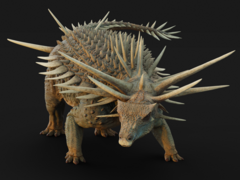What Did Scientists Discover About the Punk Rock Dinosaur with Metre-Long Spikes?

Published: 2025-08-27 15:18:05 | Category: technology
Scientists have made a remarkable discovery of a bizarre armoured dinosaur, Spicomellus afer, known for its metre-long spikes protruding from its neck. This species, which lived approximately 165 million years ago, is the oldest member of the ankylosaur group, prompting researchers to rethink the evolutionary history of these unique dinosaurs.
Last updated: 26 October 2023 (BST)
Key Takeaways
- Spicomellus afer lived 165 million years ago and is the oldest known ankylosaur.
- The dinosaur showcases unique features, including fused spikes on its bones.
- The discovery challenges previous theories on ankylosaur evolution and armour development.
- It was found in Boulemane, Morocco, marking the first ankylosaur discovery in Africa.
- Researchers speculate that the elaborate armour may have had a display function initially.
Understanding Spicomellus afer
The discovery of Spicomellus afer has taken the scientific community by surprise, revealing a creature with an intricate and unusual armoured structure. This species existed during the Jurassic period, roughly 165 million years ago, and its fossils were unearthed in Morocco. The features of Spicomellus, particularly its spikes, challenge long-held assumptions about the evolution of ankylosaurs.
The Significance of the Discovery
Prof Richard Butler from the University of Birmingham, who co-led the research, described Spicomellus afer as the "punk rocker" of its time due to its striking appearance. The term reflects the animal’s unconventional and elaborate physical features, much like the punk rock subculture known for its distinctive style. This unique morphology invites scientists to reconsider how ankylosaurs evolved and adapted over millions of years.
Physical Characteristics
Spicomellus afer is characterised by its bizarre body armour, which includes metre-long spikes fused directly onto its bones. Prof Susannah Maidment, co-leader of the project, pointed out that such fusion of spikes to the bone is unprecedented among both extant and extinct species. The dinosaur is also noted for a bony collar around its neck and a potential weapon at the end of its tail, making it a standout find among dinosaur fossils.
Rethinking Ankylosaur Evolution
Traditionally, it was believed that ankylosaurs began with simpler forms of armour, which evolved into more complex structures as a defensive measure against large carnivorous predators like Tyrannosaurus rex. Prof Butler expressed his initial expectations, stating that he would have anticipated a simpler armoured dinosaur as the oldest ankylosaur. Instead, the discovery of Spicomellus afer suggests that these dinosaurs may have started with sophisticated armouring features that later simplified over time.
Speculations on Armour Functionality
Researchers are now speculating that the spikes and other armoured structures of Spicomellus afer may have served a dual purpose. Initially, they might have been used for display, possibly to attract mates or intimidate rivals, akin to the elaborate displays seen in some modern animals. It is only later, during the Cretaceous period, that these features could have transitioned into functional armour for defence against larger predators.
The Discovery Process
The fossils were discovered by a local farmer in Boulemane, Morocco, which is significant as it marks the first ankylosaur find on the African continent. Prof Butler described the moment he encountered the fossils as "jaw-dropping" and "spine-tingling." This excitement stems from the realisation that the findings were not only unique but also substantial enough to provide insights into the evolutionary history of ankylosaurs.
Contributions to Moroccan Science
Leading the Moroccan research team, Prof Driss Ouarhache from the Université Sidi Mohamed Ben Abdellah emphasised the importance of this study in advancing scientific research in Morocco. This discovery not only sheds light on the region's prehistoric life but also highlights the potential for future discoveries in the area.
Implications for Future Research
The implications of this discovery extend beyond just the study of ankylosaurs. It opens up new avenues for research into the evolutionary biology of dinosaurs, particularly how they adapted to their environments and the challenges they faced over millions of years. As more fossils are uncovered, it may become possible to construct a more detailed picture of the ecological dynamics of the time.
Published Research
The findings of this research have been published in the journal Nature, providing a scientific basis for the conclusions drawn by the researchers. This scholarly work will likely influence future research and discussions regarding dinosaur evolution and the characteristics of prehistoric life.
Conclusion
The discovery of Spicomellus afer not only adds to our understanding of ankylosaurs but also serves as a reminder of the complexities of evolution. As scientists continue to study this unique dinosaur and its implications, it raises fascinating questions about the nature of prehistoric life and how animals adapt to their environments. What other secrets might remain buried in the fossil record, waiting to reshape our understanding of the past?
#DinosaurDiscovery #SpicomellusAfer #Ankylosaurs
FAQs
What is Spicomellus afer?
Spicomellus afer is an ancient armoured dinosaur that lived approximately 165 million years ago, known for its distinctive metre-long spikes and being the oldest member of the ankylosaur group.
Where was Spicomellus afer discovered?
The fossil remains of Spicomellus afer were discovered in Boulemane, Morocco, marking the first ankylosaur find on the African continent.
Why is the discovery of Spicomellus afer significant?
This discovery challenges previous theories about the evolution of ankylosaurs, suggesting that they may have started with complex armour features that later simplified over time.
What do the spikes on Spicomellus afer signify?
The spikes may have initially served a display function for mating or intimidation, transitioning to a defensive role as larger predators emerged during the Cretaceous period.
What does this discovery mean for future dinosaur research?
The discovery encourages further exploration of prehistoric life in Morocco, potentially leading to more significant finds that could reshape our understanding of dinosaur evolution and ecology.



